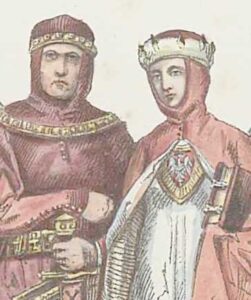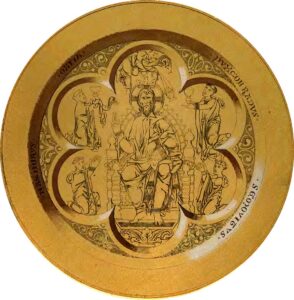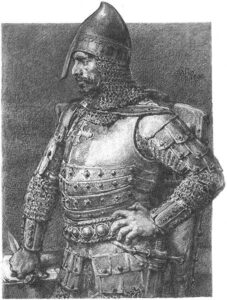Did Conrad of Masovia’s wife contribute to one of the most controversial events in 13th-century Polish history? Historians still disagree. Some see her as a caring mother and capable administrator, others – as a woman who pushed her husband into the arms of the Order. What was the truth?
At the Masovian Court
Agafia came from an influential Ruthenian family and was the daughter of Prince Sviatoslav. She arrived at Conrad of Masovia’s court probably before 1211 – when the first mention of their marriage appears. She was several years older than her future husband, which was considered unusual at the time. However, this age difference did not prevent the couple from building a lasting relationship. Their union lasted four decades – until the duke’s death.
Surviving sources suggest that Agafia was an extraordinarily energetic woman who enjoyed excellent health. In the first two decades of their life together, she bore Conrad at least nine children. Some scholars, citing less reliable sources, mention even seventeen offspring. The last child, Mieszko called Chościsław, was born when the duchess was already over forty years old.
In the early years of marriage, Agafia focused on raising children. Over time, however, she became increasingly involved in political affairs. It is known that she participated in land grants and supported her husband in managing the extensive duchies of Masovia and Kuyavia.

Agafia’s name first appears in a document from 1221, where – alongside Conrad and their sons – she appears as a donor of the village of Koskowo to the monastery in Czerwińsk. In subsequent years, her presence in sources continues. In the so-called Kruszwica forgery from around 1230, although the document is now considered falsified, she is mentioned as a co-decision maker regarding the donation of Chełmno land. In historians’ assessment, such an indication could not have been accidental – the duchess must have been a person of importance at court at the time, actively interested in her husband’s politics.
Inspirator of Inviting the Order?
Agafia was not limited only to family or ceremonial matters. Her involvement in regional security issues is documented by chronicler Peter of Dusburg, among others. He described a situation from 1226 when the duchess personally arranged for the treatment of two Teutonic brothers wounded during one of the Prussian raids on Masovia.
Although there is no unambiguous evidence that it was Agafia who suggested to her husband the idea of inviting the Teutonic Knights to Poland, it is difficult to ignore her role in this process. Many scholars believe she supported this initiative, considering it a way to protect against repeated pagan attacks. It is worth noting that at this time Masovia particularly suffered from devastating raids by Prussian tribes – so it is not surprising that the ducal couple sought military support.
In Polish historiography, there is a strong tradition of attributing decisive influence to Agafia regarding the decision to invite the Teutonic Order to Chełmno land. Especially in older publications, there appears a suggestion that she „convinced” Conrad to this controversial cooperation. Was this justified?
Some historians, such as Henryk Łowmiański and Stanisław Kętrzyński, pointed out that women in ducal circles often had real influence on political decisions. However, there is no hard evidence that Agafia was the author of this initiative. It is possible that she actively supported it, but she could equally well have merely accepted an already prepared plan.

Agafia’s Black Legend
There is no shortage of sources that present Agafia in an unfavorable light. According to the „Chronicle of Greater Poland”, it was she who was supposed to have suggested to her husband the idea of taking treasure from refugees – possibly the princes of Chernigov, who in 1240 took refuge at the Masovian court, fleeing from the Mongols.
Similar accusations also appear in the „Galician-Volhynian Chronicle”, where Agafia was presented as a person having a bad influence on her husband. According to the author’s account, Duke Conrad often yielded to her influences – and this did not always work out well for the duchy.
Such portrayals of women were common in medieval accounts, where the influence of wives and mothers was often considered disturbing or even ruinous. In Agafia’s case, however, the bad PR could also have been the result of later dissatisfaction with the Teutonic Knights’ activities – it was easier to point to a scapegoat than to admit to political mistakes.

An Execution That Shook the Church
In 1229, an event occurred in the Masovian duchy that long shook relations between secular and ecclesiastical power. Scholastic Jan Czapla – an educated clergyman held in high regard – was arrested, brutally beaten, tortured, and then murdered. Jan Długosz described this matter in detail, attributing responsibility not to Conrad himself, but to his wife.
According to the chronicler’s words, it was Agafia who was supposed to have ordered the execution of the punishment. First the clergyman was flogged, then his bones were broken, then he was strangled, and finally – hanged. When it seemed he had been sufficiently humiliated, Agafia – as Długosz reports – ordered… the corpse to be hanged again, to give vent to her own anger and probably also to intimidate those around her.
Is Długosz’s story based on facts? Historians disagree. Some scholars believe the description was taken from a non-surviving Dominican annals. Others, however, like A. Teterycz-Puzio, point to something different – namely the narrative scheme used by the chronicler. As the researcher notes: „A positively valued duke had a merciful wife, a hated duke – an evil wife. Długosz judged Conrad harshly, so he did not leave Agafia a good name either”.

Regardless of who exactly issued the execution order, the consequences were serious. Archbishop Pełka of Gniezno did not hesitate to place Conrad of Masovia under excommunication and the entire diocese under interdict. The administration of sacraments was suspended throughout the duchy, masses were not celebrated. Masovia was excluded from the Church for many months.
Between a Rock and a Hard Place
During the period of intensified efforts for Cracow and during Conrad of Masovia’s brief rule in Cracow, Agafia actively participated in assemblies organized by her husband. In July 1239, she participated in the assembly in Przedbórz, and a year later – in Iłów.
At the second assembly, they most likely discussed the matter of disobedience by Casimir Conradowic (son of Conrad and Agafia), whose cruel rule in Kuyavia met with a sharp response from the local knighthood. Under the document issued in Iłów, Conrad, with the consent of Agafia and his sons, exchanged the village of Bożęcin with the monastery in Czerwińsk for the villages of Pepeż and Służew.
See also: Wierzchoslawa – The Love of Boleslaw the Curly’s Life
The duchess, as everything indicates, sided with Conrad in the conflict between father and son. She was most likely also a strong advocate for their reconciliation, because she was present at the assembly in Piątek (January 19, 1241), where in a document issued by Bolesław for the bishopric of Płock, alongside Conrad, Agafia and their two sons (Siemomysl and Siemowit), Casimir’s chancellor Peter was mentioned.
Agafia During the Struggle for Cracow
As historians emphasize, Agafia also engaged in other initiatives by Conrad of Masovia. Her unrestrained ambition pushed her toward taking control of the Cracow duchy, which would allow not only for strengthening the material position of her husband and sons, but also for increasing prestige and gaining symbolic control over all Piast lands. The woman may have led to the kidnapping of Henry the Bearded in 1229, her husband’s main competitor. It seems unlikely that the duchess was unaware of her husband’s plans, which brought her much closer to realizing her political goals.
The Ruthenian must have also played some role (though it’s hard to say what) in concluding the agreement with Henry, who regained his freedom in exchange for renouncing his rights to Cracow. The agreement concluded on this occasion was sealed by the betrothal of Agafia’s teenage sons Bolesław and Casimir to the still minor Silesian princesses Gertrude and Constance, granddaughters of Henry the Bearded.
As one might guess, Agafia must have deeply felt Conrad of Masovia’s defeat at the hands of Bolesław V the Chaste at Suchodół (1243). The defeat did not, however, discourage her husband from making further attempts to control Cracow land. In 1246, Conrad’s armies appeared with Lithuanian reinforcements in Bolesław the Chaste’s duchy. According to Jan Długosz, this invasion was provoked by Agafia, who wanted to take revenge for Conrad’s defeat at Suchodół.
See also: Saint Kinga: The Princess Who Became a Nun
The Duchess’s Final Years
A major blow to the Ruthenian duchess was the death of her husband on August 31, 1247. She certainly shed many tears over this, as she understood Conrad of Masovia like no one else. She buried his body with due respect in Płock Cathedral, which was noted by several sources, including the „Greater Poland Annals” and the „Chronicle of Greater Poland”.
In the same year 1247, Agafia’s name was mentioned in sources for the last time. This was done on the occasion of a document issued by her son Bolesław granting the village of Żukowo to the bishopric of Płock. The discussed act mentioned knight Lasota, Agafia’s cup-bearer. It is difficult to determine whether Lasota was just then included in the duchess’s court or whether this happened much earlier. It is known that Lasota was an equerry until 1231 and then treasurer of Conrad of Masovia until 1238.
We also do not know when Agafia departed this world. Scholars assume this happened shortly after her husband’s death, and her body rested beside her husband in Płock. Even during her lifetime, she must have seen how her three sons (Casimir, Bolesław, and Siemowit) turned against each other, starting a fratricidal war. Casimir emerged victorious, wresting the Duchy of Łęczyca-Sieradz from Bolesław. Fortunately, the conflict was resolved in time, and Bolesław reconciled himself to the loss of part of his lands.
See also: The Tragic Death of Leszek the White, Husband of Grzymisława
It is difficult to say what role Agafia played in the fratricidal struggles. Contemporary sources are completely silent on this matter. She could have adopted two attitudes. Either she strove to reconcile her feuding sons, using the position and authority built in previous years, or she passively watched the development of events due to her advanced age, which made it impossible or difficult to conduct politics, which combined with grief over the death of her recently deceased husband seems quite well justified.
Bibliography:
-Dąbrowski D., Genealogia Mścisławowiczów, Kraków 2008.
-Deptuła C., Krąg kościelny płocki w połowie XII w., „Roczniki Humanistyczne” 1959, t. 8, z. 2.
-Gieysztor A., Trzy stulecia najdawniejszego Mazowsza (połowa X – połowa XIII w.), [w:] Dzieje Mazowsza, t. 1, red. H. Samsonowicz, Pułtusk 2006.
-Kętrzyński W., O powołaniu Krzyżaków przez ks. Konrada, Kraków 1903.
-Koczerska M., Mentalność Jana Długosza w świetle jego twórczości, „Studia Źródłoznawcze” 1970, t. 15.
-Kotljar M.R., Z historii polityki zagranicznej książąt halickich i wołyńskich w XIII wieku, „Mazowieckie Studia Humanistyczne” 2000, R. 6, nr 1–2 .
-Labuda G., Zaginiona kronika z pierwszej połowy XIII w. w Rocznikach Królestwa Polskiego Jana Długosza. Próba rekonstrukcji, Poznań 1983.
-Majorow A.W., Ostatnia wyprawa Romana Mścisławicza (z dziejów polityki zagranicznej Rusi Halicko-Wołyńskiej), „Klio” 2010, nr 14.
-Nagirnyj W., Polityka zagraniczna księstw ziem halickiej i wołyńskiej w latach 1198 (1199) – 1264, Kraków 2011.
-Okraszewska I., Agafia (1191/6–1247?), księżna mazowiecka, krakowska i łęczycka, [w:] Niebem i sercem okryta. Studia historyczne dedykowane dr Jolancie Malinowskiej, red. M. Malinowski, Toruń 2003.
-Samsonowicz H., Konrad Mazowiecki (1187/88 – 31 VIII 1247), Kraków 2008.
-Szymaniak M., Biskup płocki Gedko (1206–1223). Działalność kościelno-polityczna na tle procesu emancypacji Kościoła polskiego spod władzy książęcej, Toruń 2007.
-Szymczakowa A., Księżniczki ruskie w Polsce w XIII w., „Acta Universitatis Lodzensis. Zeszyty Naukowe Uniwersytetu Łódzkiego. Nauki Humanistyczno-Społeczne”, seria 1, 1978, z. 29.
-Teterycz-Puzio A., Konrad I Mazowiecki. Kniaź Wielki Lacki (1187/89 – 31 sierpnia 1247), Kraków 2019.
-Teterycz-Puzio A., „…okrucieństw[em]… przepełnione było serce brata Leszka Białego, księcia Mazowsza i Kujaw Konrada”. Wokół czarnej legendy Konrada Mazowieckiego, „Studia Historyczne” 2011, t. 54, nr 3–4.
-Teterycz-Puzio A., Na rozstajnych drogach. Mazowsze a Małopolska w latach 1138–1313, Słupsk 2012.
-Teterycz-Puzio A., Polityka Konrada Mazowieckiego wobec możnowładztwa, „Słupskie Studia Historyczne” 2009, t. 15.
-Teterycz-Puzio A., Postawa przedstawicieli elity mazowieckiej i małopolskiej wobec polityki Konrada Mazowieckiego, „Słupskie Studia Historyczne” 2003, t. 10.
-Trawkowski S., Po zabójstwie scholastyka Jana Czapli, [w:] Personae, colligationes, facta, red. J. Bieniak, Toruń 1991.
-Wilamowski M., Konrad I Mazowiecki, [w:] Piastowie. Leksykon biograficzny, red. S. Szczur, K. Ożóg, Kraków 1999.
-Włodarski B., Polityczne plany Konrada I Mazowieckiego, „Rocznik Towarzystwa Naukowego w Toruniu” 1971, t. 76.
-Włodarski B., Polska i Ruś 1194–1340, Warszawa 1966.
Author: Gabriela Zapolska